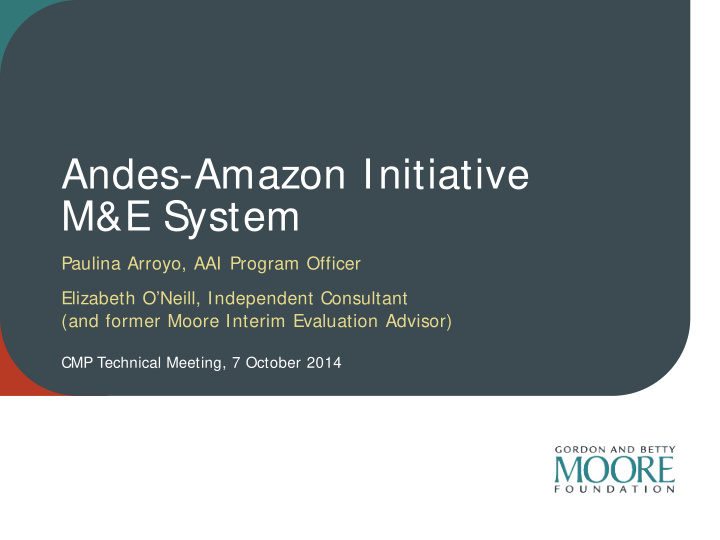



Andes-Amazon Initiative M&E System Paulina Arroyo, AAI Program Officer Elizabeth O’Neill, Independent Consultant (and former Moore Interim Evaluation Advisor) CMP Technical Meeting, 7 October 2014
Amazon 2001 PA Baseline 2001 PA Baseline No forest 2002 2
Amazon Conservation Area Status 2012 with Indigenous Areas 2001 Baseline 2012 Progress Indigenous Deforested 3
AAI Priority PA Mosaics 11 8 1 2 10 4 3 12 9 5 7 6 4
DESIGNING AAI M&E: WHAT QUESTIONS DID WE WANT TO BE ABLE TO ANSWER? Two time-scales for assessment • Regular, ‘real-time’ feedback (POs constantly; Initiative semi-annually?) • Periodic evaluation (External evaluation) But questions are the same… • Are we doing the right things? (Relevance) • Are we doing things right/well? (Efficiency) • Are we moving things in the right direction? (Effectiveness) • Are we ultimately driving meaningful change? (Impact) • Will our results last? (Sustainability) • And of course, based on answers to the above: What can we do better?? 5
A FEW DESIGN CONSIDERATIONS • Right info to answer the key questions • Do-able/Usable • Toyota versus Tesla • Responsive to several users/audiences: – Broad applicability to grantee partners – AAI program director and officers (regular oversight) – Roll up for senior management & board 6
AAI M&E SYSTEM: EFFECTIVENESS To assess EFFECTIVENESS, must know status of key factors targeted by each strategy. Example—Strategy: System Sustainable Finance Mechanism for PA System What AAI tracks annually: • Stage of setup of each finance mechanism (1: Discussion/ Design, 2: Develop/ Set-up, 3: Funding/ Fundraising, 4: Implementation) • Extent to which funds in mechanism can meet recurring costs of targeted ha of PAs (measured in %) 7
AAI M&E SYSTEM: EFFICIENCY To assess EFFICIENCY, must track inputs and outputs For each strategy, AAI tracks annually: • Grantmaking in support of each strategy (USD) • Delivery of milestones (Dropdown status menu--Abandoned: Not strategic; Abandoned: Not feasible; Advanced to next year; Achieved) TONES P A S YS TEM S US TAINABLE FINANCE: MILES Outcome Target 2013 2014 2015 Ref # Abbreviation Milestone ear Status Status Status Notes/ Comments Y 2013 Achieved N/ A N/ A P A$ Finance Deal to secure donor funds and mechanism leverage federal budget agreed by 1.1 stakeholders. Finance Legislation and policy created to secure 2014 N/ A N/ A P A$ mechanism permanent funding to protected areas. 1.1 8
AAI M&E SYSTEM: IMPACT 2018 THREAT 1. Chiri-Caqueta To assess IMPACT, must know biodiversity status: Jun 2013 Nov 2014 end 2015 end 2016 Regulated Threats Example of Unconstrained Initiative Outcome: Logging—Commercial LOW Biodiverse forest conserved and appropriately Agriculture—Commercial MEDIUM Grazing, ranching HIGH distributed across the basin. Mining—Commercial MEDIUM Oil & Gas MEDIUM Roads What AAI tracks: Forest cover of the Amazon N/A Dams N/A Basin Waterways N/A Unregulated Threats Illegal Logging LOW Example of Constrained Initiative Outcome: By 2016, Illegal grazing, ranching LOW forest cover loss and vulnerability to future Hunting, Fishing LOW Agriculture—Subsistence LOW deforestation & degradation is reduced in the PAs Mining—Artisanal LOW NTFPs LOW captured by the 12 priority AAI mosaics, as evidenced OVERALL THREAT RATING HIGH by reductions in mosaic 5-year (2018). 2033 THREAT 1. Chiri-Caqueta Jun 2013 Nov 2014 end 2015 end 2016 What AAI tracks for each mosaic: Forest cover Regulated Threats Mining—Commercial HIGH change, 5-yr threat projections, 20-yr threat Oil & Gas LOW Roads LOW projections Dams N/A Waterways MEDIUM Unregulated Threats Climate Change (on forest) N/A 9 OVERALL THREAT RATING HIGH
AAI M&E SYSTEM: SUSTAINABILITY To assess SUSTAINABILITY (of results), must know status of “Durability Factors.” For each mosaic, every couple of years, AAI assesses status of: 1. Knowledge (for mgmt., Including baseline conditions, regular monitoring) 2. Law & policy: policy, legislation, enforcement 3. Constituency: stakeholder mass, makeup, engagement & support 4. Capacity: stakeholder ability to affect change 5. Capital: conservation funding Using qualitative scale of: 1. Factor is in a POOR state such that it significantly impedes conservation 2. Factor is in a FAIR state (i.e., somewhat impedes conservation) 3. Factor is in a GOOD state (i.e., not limiting but could be improved) 4. Factor is in a VERY GOOD state (i.e., ideal state for conservation) Note: These complement individual PA consolidation factors that are also tracked 10
AAI M&E SYSTEM: PROS/CONS Strengths: • Limited number of indicators to track—can compare across mosaics • Most factors tracked relevant to partners/grantees—working with them to collect/validate data • Uses rating scales wherever possible/practical to enable analysis, promote consistency, and increase ease of updating (dropdowns) • Rolls up to a dashboard • Links $ to results Limitations: • Supports correlation and contribution versus causality and attribution • Although basic, still difficult to get data and find time to fill in • Very pared down, but senior management still says too complicated • Excel-based versus user-friendly relational database 11
GROUP DISCUSSION IDEAS • Feedback? • Examples of other approaches at similar scales (particularly in funder setting) • How do you get the data you need and ensure quality? How do you ensure compatibility with grantee/partner information needs so you don’t add transaction costs? • How sophisticated do M&E systems need to be? Do we absolutely need to know attribution/direct causality? Does seeking that ideal impede M&E system effectiveness/use? 12
Recommend
More recommend